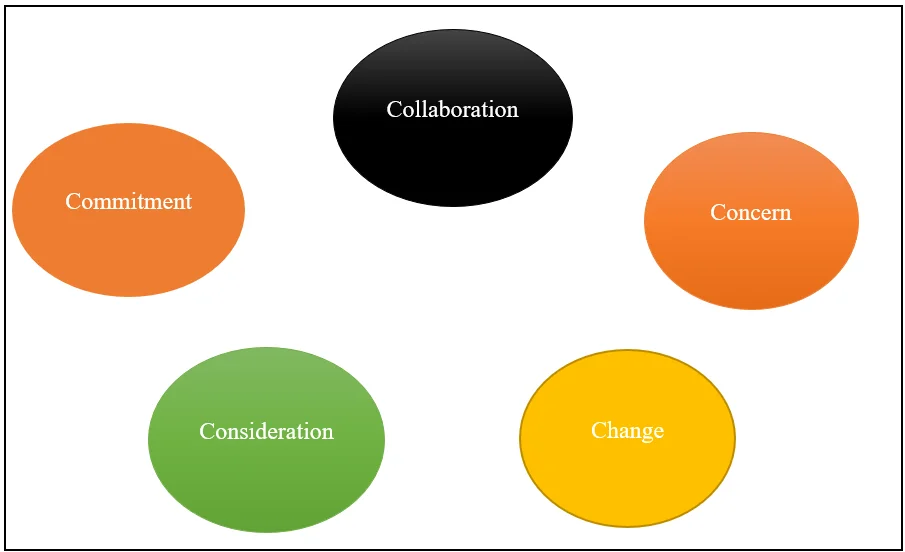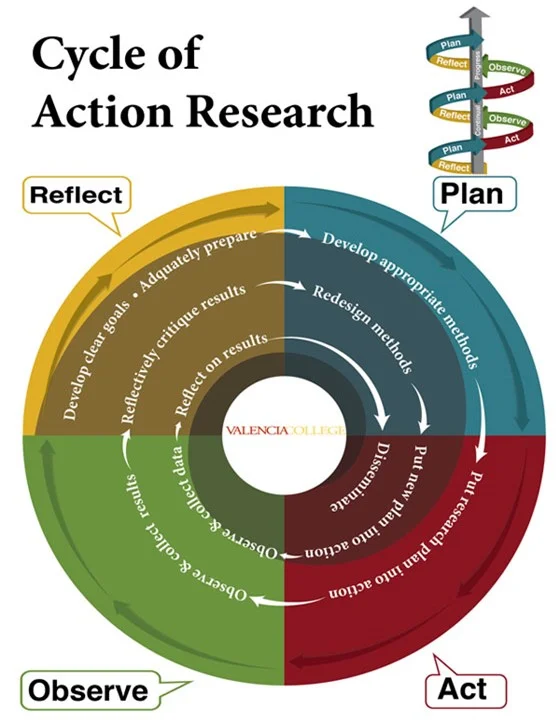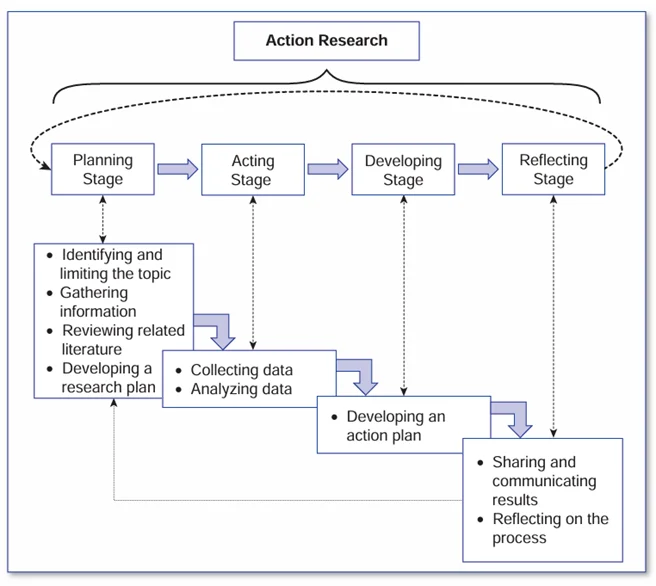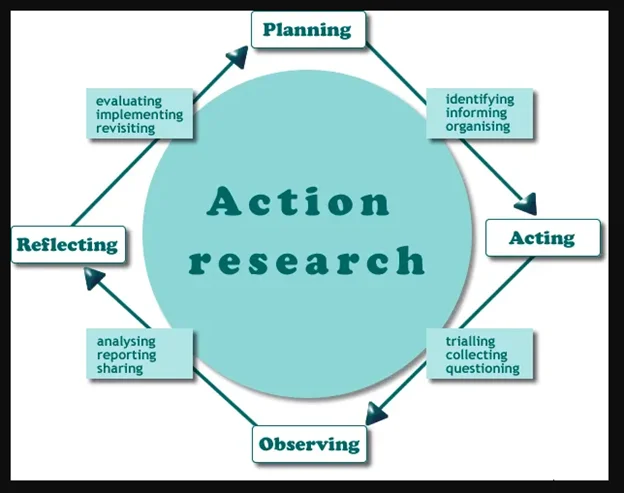The Kurt Lewun, a German-American psychologist, is considered the pioneer of this discipline, coining the term “action research”. Another researcher, Stephen M. Corey, was the first to introduce the concept of the action research process. “A number of people have referred to action research as the process by which practitioners attempt to study their problems scientifically in order to guide, correct, and evaluate their decisions and actions.” The purpose of the action research is to provide information or problem solving at the individual and community levels that impact teaching, learning, and other related processes. Action research’s role is to promote critical thinking and self-reflection. This research provides a practical solution at a specific point and directs decision-making in the right direction.

Role of The 5 C in Action Research

Action research is the process by which practitioners attempt to study their problems scientifically in order to guide, correct, and evaluate their decisions and actions.

The Methods of the Action Research
Operational Action Research
Technical action research, also known as this, begins with planning, acting, observing, and reflecting.
Collaboration Action Research
The collective understanding of the problem and aspects of the research helped establish community-shared information, leading to change and improvement in the particular area.
Critical Reflection Action Research
The process making in which set of goals, what we have learnt in past and information about the future that consider the impact of the life and the process of the thinking.

The Stages of the Action Research

Process of Action Research
Identify and defining a problem
Define the problem or issue that you intend to address through your research in a clear and concise manner. The information should be specific, actionable, and pertinent to the context in which you are working.
Action planning
Action research is a methodical approach that is utilized by researchers, educators, and practitioners in order to identify and implement solutions to problems or challenges that are embedded within a particular setting. A cyclical process of planning, implementing, reflecting, and adjusting actions based on the data collected by the organization is involved in this process.
Reviewing the Related Literature
The key sources should be analyzed and summarized, their contributions should be evaluated, and relationships between the sources should be identified. A literature search, an evaluation of sources, an analysis of findings, and an interpretation of those findings are all required in order to discuss the current state of research on the subject.

Developing a Research Plan
Action research typically consists of the following steps: identifying a problem, reviewing relevant literature, designing interventions or changes, collecting and analyzing data, reflecting on findings, and implementing improvements based on the results of the research.
Selecting a course of action
When deciding what course of action to take, it is important to take into account the goals, the potential outcomes, and the long-term implications. Conduct data analysis, solicit feedback from your team, and draw on your previous experience as a leader in order to arrive at well-informed decisions. In my opinion, determining the criticality of a solution is also very important.
Evaluating
Action research and evaluation research are two types of research that concentrate on the process of developing, implementing, and testing a program, product, or procedure. They almost always take place in educational institutions, and they are frequently carried out by or with the assistance of educators, administrators, and other practitioners.
Studying the consequences of an action
The purpose of action research is to find a solution to a problem or to inform individual and community-based knowledge in a manner that has an effect on teaching, learning, and other processes that are related to these areas. Instead of focusing on providing theoretical input, it is more concerned with producing input that can be put into action.
Specifying learning
Teachers investigate their professional practices in order to develop a better understanding of teaching and student learning, as well as to improve educational practices by developing a plan for action or change. This type of research is known as action research on learning.
Identifying general findings
In an empirical research paper, the section “Results,” which is also sometimes referred to as “Findings,” provides a description of what the researcher(s) discovered after conducting an analysis of their data. In spite of the fact that the findings contradict the hypothesis, its primary objective is to make use of the data collected in order to provide answers to the research question(s) that were posed in the introduction.

Characteristics of Action Research
- Based on empirical research
- It’s a type of applied research.
- It’s helpful to evaluate local problems.
- Provide solutions to immediate problems.
- Objective in nature
- The local population is limited.
- Cyclic process
- The scope is broad.
- Flexible in nature

Practical Example of the Action Research
By following these steps, a company can effectively apply action research to improve leadership development. By following these steps, a company can effectively apply action research to improve leadership development.
Identify A Focus Area
Define the Problem: Identify a specific leadership development concern or problem in the organization, including but not limited to leadership skill development, teamwork, or organizational culture transformations.
Formulate a Research Question: Formulate a clearly defined primary research question that tackles the identified issue, such as, “To what degree will the middle managers of the firm enhance their leadership skills to enhance team performance?”
Conduct A Literature Review
Relevant Literature Review: Conduct a critical analysis of the literature in the areas of leadership development, organizational change, and action research.
Analyze Findings: Look for areas of controversy that will provide direction and focus to your study, as well as information that may seem to contradict itself.
The Next Critical Step Is To Devise A Plan Or Strategy
Design an Intervention: Develop an action plan on how to solve the identified leadership development issue.
Engage Stakeholders: Engage the diverse individuals within the organization, including employees, managers, and human resource professionals, to verify the feasibility and applicability of the development.
Collect Data
Employ a Variety of Methods: We will collect data through observation, interviews, questionnaires, and reflective diaries.
Focus on Practical Reflection: Apply self-reflection to the leadership practice and reflect on interventions’ actions and consequences.
Take Action
Implement the Plan: Implement the plan and analyze the results obtained for the purpose of evaluating the plan and achieving the goals set.
Monitor Progress: Follow the plan’s development and make changes to the schedule on a daily basis.
Reflect On And Analyze The Data
Reflect on the Outcomes: Evaluate the consequences of the actions taken.
Analyze Data: Next, evaluate the collected data to gauge the effectiveness of the applied intervention strategies.
Identify Areas for Improvement: Draw additional optimization areas and adapt your plan.
I Noticed What Others Said, Thought About It, And Shared New Results Together
Share findings: Discuss the outcomes of the action research with other employees and/or stakeholders.
Reflect Further: Review the process to refine it and plan for further improvement.
Engage in Ongoing Learning: It means, require the members of the community to remain in the action research process so that learning never stops and the process is always improving.
Embrace Communication and Encourage Reflection
Promote Collaboration: Promoting the culture of collaboration you have to involve the employees in the research and action phases.
Encourage Reflection: Motivate people to think about their work processes, make analyses of the results, and draw conclusions from the positive and negative results.
Develop Change Agents: Define the subjects of change that can and will promote the change and become change champions in the organization.
Therefore, the model to be used in the current study is the Action Research Model for Continuous Improvement.
Emphasize Continuous Improvement: Applied to various strategies, reflection and evaluation results can be used to promote changes in strategy, modification of interventions, and decision making on the next steps for leadership development.
Adapt to Evolving Needs: To incorporate the third key element, a company must encourage innovation and learning to meet changing needs and requirements.

Thus, it is possible to state that action research can become a powerful means for enhancing the leadership development practices in a company and supporting organizational culture with values as collaboration, reflection, and change.
Dr. Abid Hussain Nawaz



